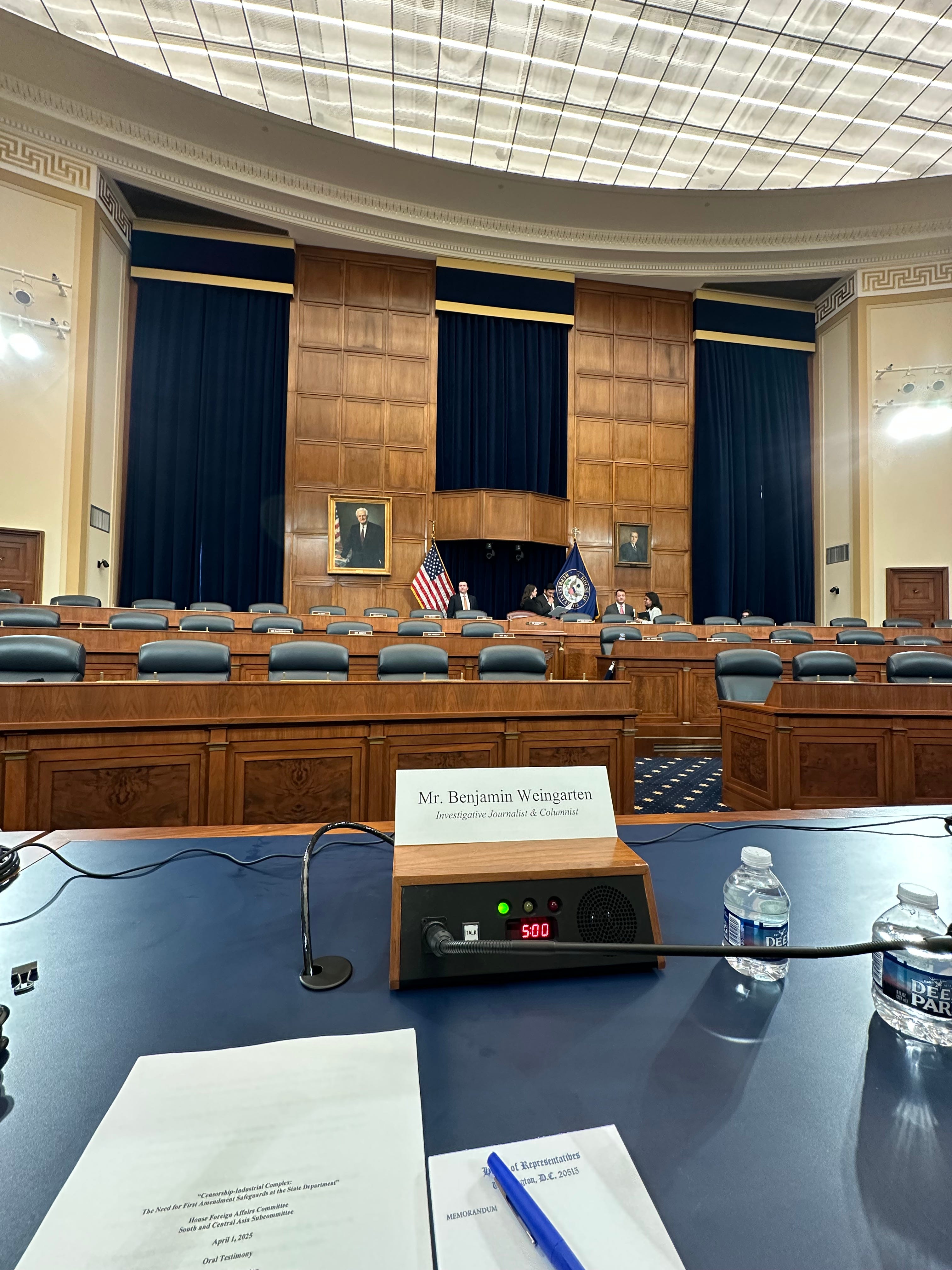To Overcome Our Adversaries We Must Not Emulate Them by Silencing Dissent From Regime Orthodoxy
My plea to Congress to restore a free and open digital public square
On Tuesday, for the second week in a row, I had the distinct pleasure of testifying before Congress.
This time, I participated in the House Foreign Affairs Committee’s Subcommittee on South and Central Asia’s hearing on “Censorship-Industrial Complex: The Need for First Amendment Safeguards at the State Department.”
I served as a majority witness alongside
’ and opposite short-lived head of the Disinformation Governance Board Nina Jankowicz.Below you can watch my opening remarks by clicking the X post, or read them following the post. The full hearing is also available to watch here.
Chairman Huizenga, Ranking Member Kamlager-Dove, and esteemed members of the Subcommittee, thank you for the opportunity to testify.
The Censorship-Industrial Complex poses a mortal threat to our republic.
This sprawling whole-of-society regime has sought to purge unauthorized opinions and inconvenient facts en masse under guise of combatting “mis-, dis-, and mal-information.”
Today’s hearing highlights one of the regime’s most insidious manifestations: The turning of federal agencies that are supposed to target foreign adversaries instead on Americans and our core political speech.
The Global Engagement Center was a key cog in such efforts through its cultivation of hundreds of ostensibly non-governmental “counter-disinformation” players.
Two players the GEC funded and promoted were “risk-raters” NewsGuard and GDI.
These relationships should have raised immediate alarm bells.
The GEC’s stated mission was to counter “foreign…propaganda and disinformation efforts.”
Yet NewsGuard aims to “systematically defund sources of harmful misinformation” foreign and domestic.
NewsGuard does so by rating and reviewing thousands of outlets for “reliability” and creating “exclusion lists” – blacklists – to feed advertisers for use in determining where not to place ads.
GDI likewise seeks to “reduce disinformation” by “remov[ing] the financial incentive” – ad revenue – it says lurks behind it.
GDI too arms advertisers with a “dynamic exclusion list” reportedly containing 2,000 “risky” publications, including American ones.
Perversely then, a foreign-facing interagency entity both funded and gave the federal government’s imprimatur to non-governmental would-be destroyers of disfavored domestic outlets.
Those outlets appear to be disfavored for ideological reasons.
NewsGuard generally lavishes significantly higher scores on left-leaning sources over right-leaning ones. Its Kafkaesque correspondence with dissident outlets broadly, who have challenged seemingly unmerited scores in vain, further suggests a bias.
GDI’s 2022 report on “disinformation risk” among U.S. sources betrays a similar bent.
There, it lists among its ten least risky publications nine liberal-to-progressive corporate media outlets…and The Wall Street Journal.
Its ten riskiest publications include nine conservative or libertarian outlets…and RealClearPolitics.
Evidence suggests the risk-raters’ profiles grew substantially after receiving federal support. Their ubiquity in the ad marketplace reportedly drove declines of tens of millions of dollars in ad revenue annually for outlets on their de facto blacklists.
Some disfavored sources report reduced traffic, diminished search visibility, and lost operational partners.
RealClear’s experience with the risk-raters is uniquely perverse.
RealClearPolitics’ bread-and-butter is curating compelling analysis – from sources left and right, corporate and independent – on key issues of the day, so readers can weigh both sides.
Consequently, media bias rater AllSides positions RCP in the ideological center, alongside
Reuters, The Hill, and The Wall Street Journal.
Despite our pursuit of fairness and quality journalism, NewsGuard gives RCP a 62 on its 100-point scale – as determined by their journalists rating a sample of our journalists’ work.
NewsGuard dings us in part for our purported undisclosed conservative bent.
The implication is that it either dismisses viewpoint diversity as a feature or sees it as a bug.
RealClearInvestigations likewise curates deep-dives and publishes original content from journalists with diverse perspectives.
NewsGuard has branded us biased too, albeit while giving RCI an 80 rating.
Our bias is to pursue stories competitors miss, or angles competitors ignore. Shouldn’t that be celebrated?
As for GDI, RCP may be on its secret blacklist too.
RealClear has thrived despite the risk-raters’ best efforts.
But the Censorship-Industrial Complex the GEC helped foster has made a tough business tougher and disadvantaged us.
Our ad revenue has declined materially.
We’ve seen a meaningful drop in certain search rankings.
And we’ve taken a reputational hit by being branded with the digital scarlet letter “R” for “risky.”
***
Even if the risk-raters were unobjectionable, the fact remains: Through funding and supporting such entities, government abridged speech by proxy.
The Trump administration and its State Department have indicated these efforts are over.
But the speech police have neither laid down their arms nor recanted for past abuses, suggesting they will at best lie in wait during Trump II -- only to come back with a vengeance thereafter.
The time to act is now.
Congress should codify the president’s first-day executive order “Restoring Freedom of Speech and Ending Federal Censorship” to permanently starve the Censorship-Industrial Complex of the federal funding and direction that are its lifeblood.
Congress should prohibit grants and contracts to institutions engaged in domestic censorship activities.
And Congress should erect a strict firewall between the U.S. government and our body politic a la Smith-Mundt.
To overcome our adversaries, we must not emulate them by casting dissent from Ruling Class orthodoxy as dangerous, and surveilling and silencing the dissenters.
Instead, let us restore the free and open public square on which our republic rests.
Thank you.




